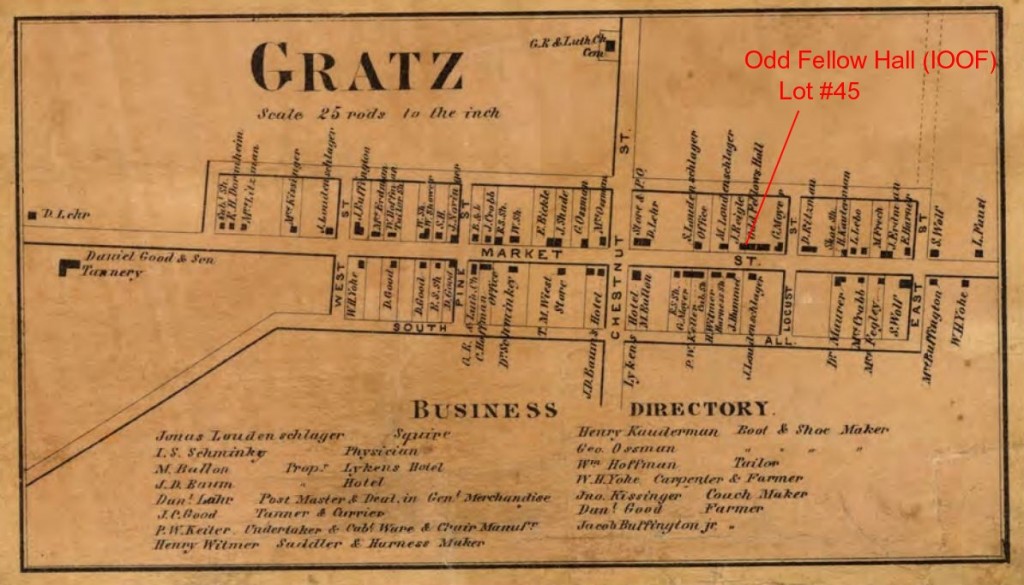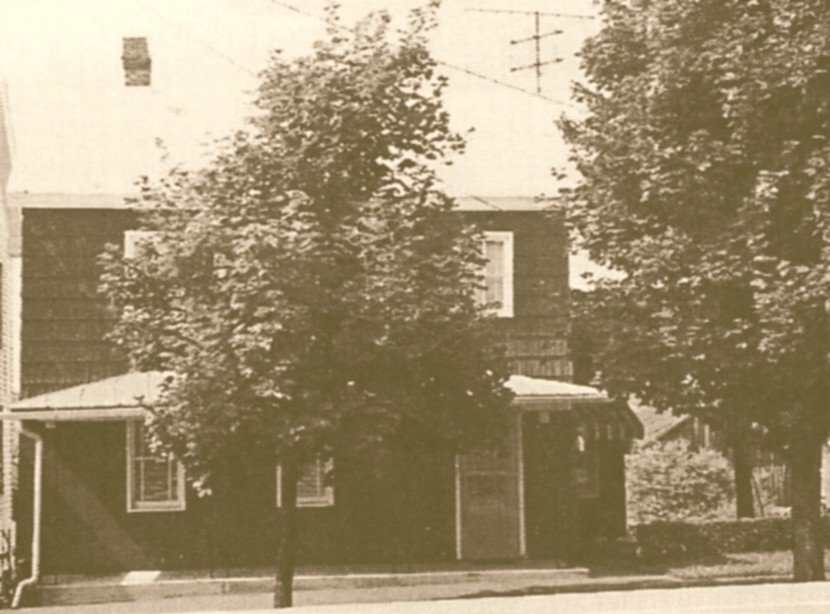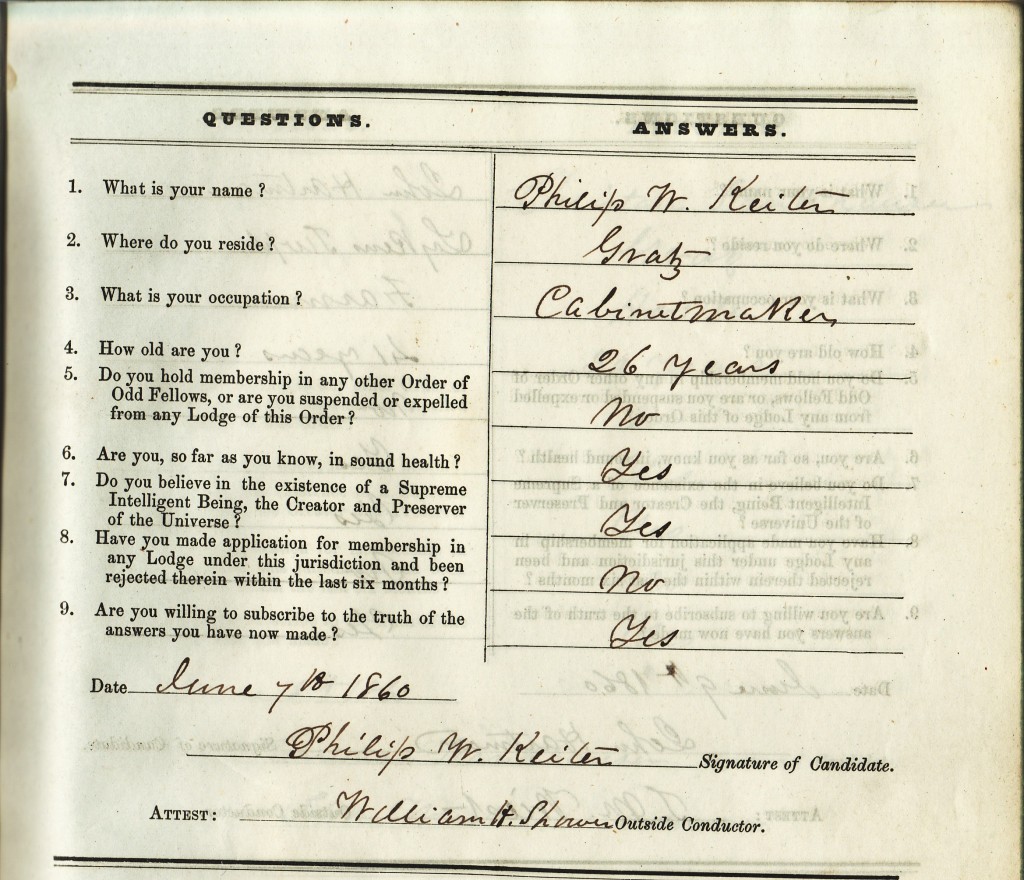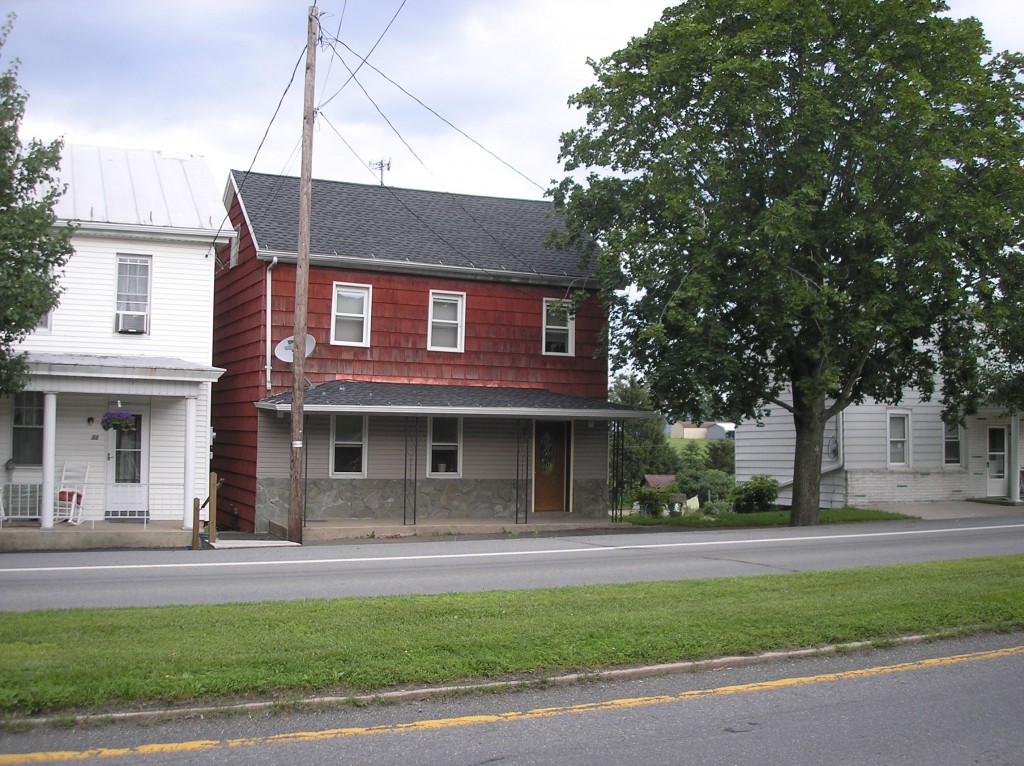Gratz During the Civil War – I.O.O.F. Building
Posted By Norman Gasbarro on September 16, 2012
The original Simon Gratz Lot #45 was first sold to Henry Freedline, who was probably a manufacturer of clothing, in 1829. Over the course of the next seven years , the lot and the building Freedline built on it was sold several times – to Peter Filbert and his wife who were inn-keepers, to Jacob Shaffer, a brick maker, to William Wingert, a chair maker, and finally to George Moyer, a shop keeper. It is not known for certain whether any of these business were conducted from this property or from the original house, but there are records to show that in this early period the house had at least one tenant, a Philip Keener. William Wingert worked at one of the taverns in Gratz and for a time served as postmaster.
George Moyer owned the property from 1836 to 1841 and did operate a general merchandise store here. In 1841, he and his wife conveyed the property to Eleanor Stine, who at the time was not married. She was the daughter of Johann Peter Stine. While owning the property, she married James Glenn, a school teacher, and conveyed the property to him. But in 1846, Johann Peter Stine purchased the property in a sheriff’s sale. When he died in 1854, and his estate was settled, it reverted back to his daughter, Eleanor [Stine] Glenn who at the time was living in Pottsville. During this period between 1854 and the next sale transaction, a tenant, John W. Whitcomb lived here.
The earliest available picture of the 1829 house on this property was probably taken in the late 20th century and is shown below.
In 1860, this property was sold to Solomon Laudenslager and Tobias M. Wiest who conveyed it to the Independent Order of Odd Fellows (I.O.O.F.), a fraternal organization that had established itself in Gratz as Lodge #563.
The I.O.O.F. was an altruistic and charitable organization that had its origins in England in the 18th century. The first lodge in North America was established in Baltimore, Maryland, in 1819 (Lodge #1) and the movement to establish lodges throughout the country was rapid in the period before the Civil War. The symbol of the I.O.O.F. is three chain links with the letters “F”, “L” and “T” standing for Friendship, Love and Truth. An interesting article on the history of the Odd Fellows can be found on Wikipedia (click here).
The history of the Gratz I.O.O.F. is still being researched, and there is a large collection of materials related to this lodge, including an original membership book which has sworn affidavits of applicants beginning in 1860. The first five applicants were: Philip W. Keiter, a cabinet maker; George Osman, a shoemaker; John Hartman, a farmer; Jonas Schoffstall, a laborer; and Christian Frankhauser, a hostler. A total of 45 applicants presented themselves in 1860 in the year before the Civil War began. No doubt, the fact that the lodge owned this lot and building resulted in the early success of the I.O.O.F. in Gratz.
The above page from the membership register shows the application of the first Gratz I.O.O.F. applicant, Philip W. Keiter, on 7 June 1860. Keiter had to attest to his residence, his occupation, his age, his health, and his belief in a the “existence of a Supreme Intelligent Being, the Creator and Preserver of the Universe” in addition to his prior or current ‘lodge-related” activities and membership. Keiter was one of the men of this lodge who served in the Civil War.
The records also show that during the early years of I.O.O.F. ownership, there was significant expansion of the facility including a kitchen and finished basement in the rear. But the lodge quickly outgrew the building and had to seek out another property to meet the needs of its rapidly growing membership. Thus, the purchase of Lot #13 was made after the Civil War (in 1872), and construction began on a grand building to house the I.O.O.F. In 1873, the lodge moved to its “new” headquarters west of Centre Street. The post tomorrow will feature the 1873 building.
According to the history of I.O.O.F., it became the first lodge in America to accept both men and women, when in 1851, it created the Daughters of Rebekah. Although the Gratz lodge was active in the period of the Civil War, not much is known about whether women participated. As a result of men going into the military, many lodges throughout the country suffered significant membership losses as a result of the war and were unable to continue their work. But the period of industrialization in the latter part of the 19th century helped to revive many of them, including the Gratz Lodge. The I.O.O.F. was probably the most important of all the fraternal organizations in the Lykens Valley area in the first twenty years of the post-Civil War period.
Just prior to the completion of the new headquarters building, this property was sold by the lodge trustees to Henry Walborn, a tinker and tinsmith. It remained in Walborn’s ownership until 1911.
This is part 36 of an ongoing series on Gratz during the Civil War. Some of the information for this post was taken from the book A Comprehensive History of the Town of Gratz Pennsylvania.
Other parts of the series on Gratz During the Civil War can be found on this blog by clicking on “Walking Tour.”
 ;
;






Comments